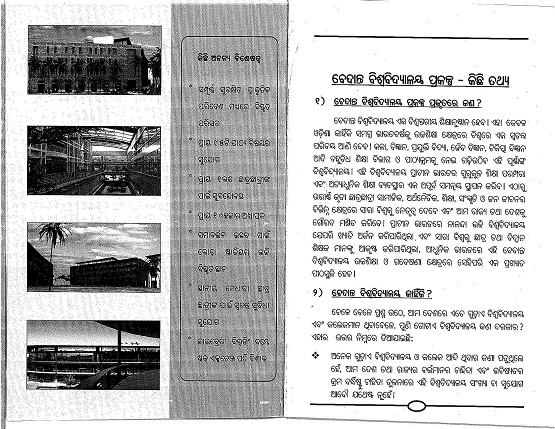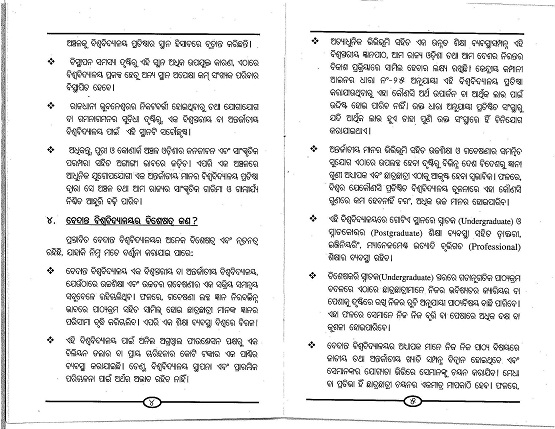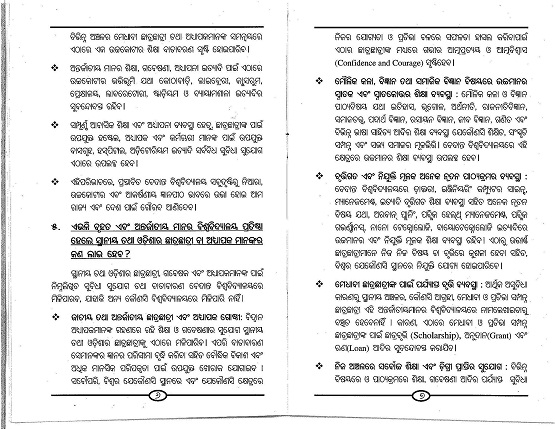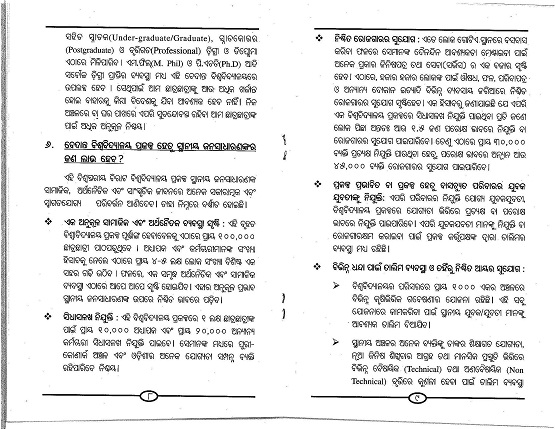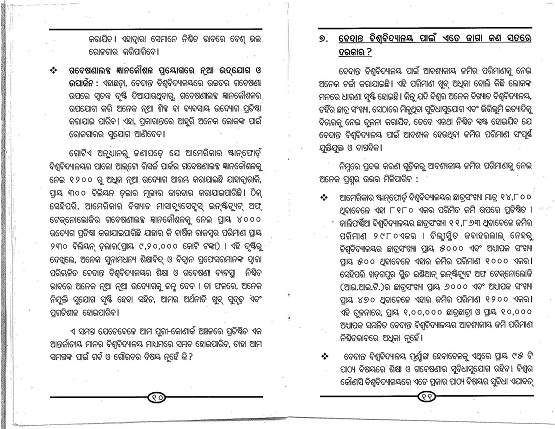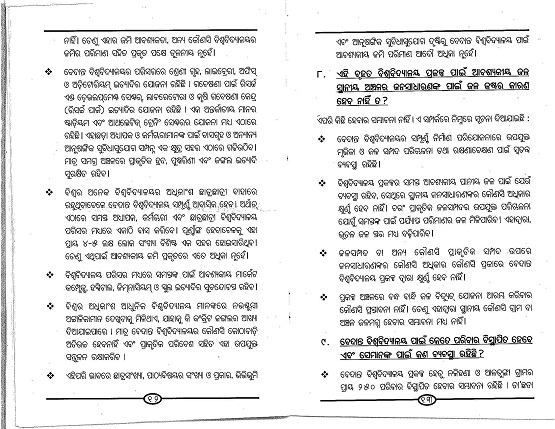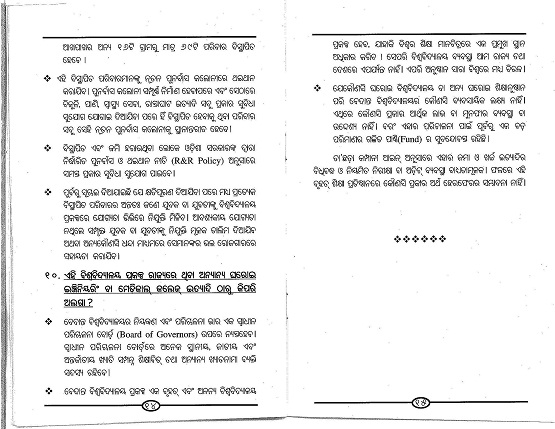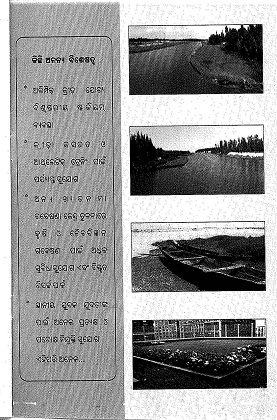Archive for September, 2010
Following are excerpts from a report in Telegraph about this institute and a new course it will offer.
A new course on craft design has been introduced at the State Institute for Development of Arts and Crafts (Sidac). The nine-month certificate course was launched in collaboration with National Institute for Design (NID), Ahmedabad. The objective of the course is to design contemporary products with an ethnic touch.
Dilip Panda, training in-charge of Sidac … Panda added that the new course was introduced after designing institutes like NID and National Institute of Fashion and Technology (Nift) conducted a series of design development programmes.
“Using traditional skills and modern design inputs, the institutes came up with more market and export-oriented products. This is also a good oppurtunity for budding talents to upgrade their skills and prosper as artisans and craftsmen,” said Panda.
The first batch comprising 20 students started classes last week.
Sunil Kumar Sahoo, who has completed a two-year training in Patachitra, has enrolled for the course. He said: “Traditional art and craft have to evolve to suit the needs and tastes of customers. In this course, we will be trained in creating new designs and product mixing. For example, Patachitra on terracotta or stone will give a brand new touch to traditional products.”
Panda said he was hopeful that the students would be able to develop a designer bent of mind with the help of skilled trainers. “We have five in-house faculty members from renowned designing institutes for teaching the core subjects. The visiting faculties would take care of specialised subjects like product photography and use of computers in design,” added Panda.
For the first year, the course is being run on an experimental basis for which the students are exempt from paying any fees. …
September 15th, 2010
Following is page 3 of the article at http://www.ias.ac.in/currsci/10sep2010/577.pdf by K. P. Raghuraman, Romesh Chander and Giridhar Madras of Indian Institute of Science. (Thanks to Abi for the pointer.)

I confirmed from one of the authors that the highlighted institute is indeed the one from Bhubaneswar. I was also told that many their publications are the result of mega-collaborations.
The above is a great achievement for Institute of Physics. Especially since they have a small faculty of 19 and have a comparatively smaller overall budget. Kudos to them for their achievements.
September 15th, 2010
Following is an excerpt from a report in Business Standard.
The newly constituted National Innovation Council (NIC) headed by Sam Pitroda, aims to have a $1-billion (around Rs 4,600 crore) fund to promote new ideas for inclusive development and innovation in the country.
“Our objective is to setup a $1-billion fund for the NIC but how big it will be depends on how the market reacts and how much money we are able to raise. We want to see if we can set up a large fund,” Pitroda, advisor to the PM, told Business Standard.
A week ago, the Council had announced the setting up of a fund with a corpus of Rs 1,000 crore to encourage innovation. The government will contribute 10-20 per cent to the fund with the rest coming from other sources like private funds, institutions and foundations.
Last month, Prime Minister Manmohan Singh had approved the establishment of the Council with a mandate to prepare a road map for the Decade of Innovation (2010-2020) by evolving an Indian model of innovation, focusing on inclusive growth and creating an appropriate ecosystem.
Going ahead, innovation councils will be set up at the state and sectoral levels and Pitroda said that five states, including Orissa and Karnataka, have already shown interest in setting up their own innovation councils. The NIC will also have innovation centres in universities and innovation clusters to create regional hubs.
It will delineate appropriate policy initiatives within the government to spur innovation. It will also promote setting up of Sectoral Innovation Councils and State Innovation Councils.
The NIC has also collaborated with industry chambers CII and Ficci to identify 20 industrial clusters in the country like Indore, Bhopal, Gandhinagar and Kanpur, among others, to provide guidelines for innovation.
“Those clusters will be selected where there is a minimum critical mass of industries of some kind and then we will give them an innovation toolkit. The toolkit will be a set of guidelines on how to innovate. Moreover, we are also selecting 20 universities, besides the Indian Institutes of Technology (IIT) where we can do seed innovation,” he said.
Prof Sanjay Dhande, IIT Kanpur director, who is a member of the Council, is in the process of identifying the universities which will then be given the innovation toolkit to be able to connect with industry.
Odisha should lobby to have at least one industrial cluster (perhaps Rourkela) in the list of 20 clusters and lobby to have at least one university in the list of 20 universities to which innovation toolkit will be given. I think VSSUT and Sambalpur University should join hands to stake claim for one of the 20 university slots. Considering their proximity, it may work.
The setting up of the innovation council was approved a month month back. Following is an excerpt from another report in Business Standard.
Last month, the prime minister had approved the setting up of the council to prepare a road map for the Decade of Innovation 2010-2020. The council also launched its portal, where a compilation of scientific achievements that could be used to improve the quality of life would be available.
A similar council called National Advisory Council on Innovation and Entrepreneurship was formed by the Commerce Department in the USA in 2009. In July 2010 its membership was announced.
September 15th, 2010
Vizag is getting antsy about the delay in the establishment of one of the aiming to be "world class" universities in that city. Deccan Chronicle reports on this issue. Following is an excerpt.
The much-touted “world-class university” in Visakhapatnam has failed to take off though it has been more than two years since the Centre announced the project.
In 2008, the Union HRD ministry had announced plans of 14 “world-class universities” across the country, of which one was allotted to Andhra Pradesh. The state government had also come forward and offered around 800 acre in Visakhapatnam to set up the varsity.
Though the university was later renamed by the Centre as “Innovation University”, officials of the higher education department are clueless about when the actual works will begin.
The state government had identified four sites in Vizag for the purpose and submitted a proposal to UMHRD for clearance. However, there has been no response from the Centre till now.
Sources in the department of higher education said the Centre’s stand about setting up the “Innovation Universities” has changed and that’s the reason for the delay.
… However, the Union minister of state for HRD, Ms D. Purandeswari said the world-class university would be a reality in Vizag in a year. “It is still being discussed how a world-class university should be. So, there is some delay. I cannot give an exact time-frame but in a year a world-class university would definitely be a reality in Visakhapatnam,’’ she said.
Note that Purandeswari is the sitting MP from Vizag.
It should be noted that a draft bill of the Universities for Innovation was circulated and discussed recently. It is expected that a revised version of it may be introduced in the parliament in the winter session. I guess following that starting from August 2011 at least a few of these universities will start operation. The 14 locations that were announced were: Amritsar, Bhopal, Bhubaneswar, Coimbatore, Gandhinagar, Guwahati, Jaipur, Kochi, Kolkata, Mysore, NOIDA-Delhi, Patna, Pune and Vizag. There will be minor funding for these universities during this five year plan. The major funding will come during the 12th plan that starts from 2012.
September 14th, 2010
Carnegie Mellon University of Pittsburg is one of the top universities in US; especially its Computer science department is ranked among the top 5 (sometimes in top 3) in US. It offers Masters programs in Software Engineering in partnership with various international institutions. One such partner is SSN School of advanced software engineering in Chennai. Following is an excerpt from their overview page:
The SSN School of Advanced Software Engineering (SSN SASE) has been established by Padma Bhushan Dr. Shiv Nadar – Chairman, HCL Technologies Ltd., to bring world class education to India and make it available to meritorious students of all economic strata.
The home page of the institution says the following:
Despite the Recession, all of MSIT students got jobs – At an average salary of US $95,000! Living expenditure in CMU reduced by Half.
Carniegie Mellon also has another program that students from India can take. Following is an excerpt from a report in redherring magazine.
At an Internet cafe in Delhi, India, up to 80 students sit pensively studying their computer screens. For some, it’s just like any other Internet cafe, but for others it’s a virtual university where they can take computer science courses offered by Pittsburgh’s Carnegie Mellon University (CMU).
The new educational initiative is a collaboration between Sterling Infotech, an Indian Internet service provider, and Carnegie Technology Education, a subsidiary of the university, and is part of an ambitious program to train more than 100,000 Indian computer programmers at 100 locations over the next three years.
It also gives us a glimpse of the changes rippling through education. Universities with expertise in one area can now prepare, monitor, and grade courses given under local supervision in an entirely different location.
"The education model is more like, say, a Microsoft, Novell, or Cisco certification program than a traditional university course," says Allan Fisher, president and CEO of Carnegie Technology Education. "We build computer-based training courses drawing on the intellectual resources of the university, but local instructors [in India] monitor, administer, and assist the students."
The courses offered range from the basic, like software engineering, to the advanced, like object-oriented programming. "However, unlike software vendor training programs that would offer courses in Visual Basic or Java, we teach students how to work with any object-orientated language," says Mr. Fisher.
…Unlike many online education institutions, Carnegie Technology Education not only designs the course but also trains and certifies the instructors and monitors both the teachers’ and students’ progress.
Carnegie Mellon computer-science faculty members design the courses and personally select and train the local tutors who will teach the students at the partner institution. "The tutors then go back to the partner institution and teach the courses; we monitor their progress, and they have access to our computer-science faculty member to assist them with any difficulties," says Mr. Fisher.
If the student completes five courses successfully, they get a Carnegie Technology Education certificate in computer programming; if they complete ten courses, they get a certificate in software engineering.
But it’s not cheap. Each course module costs the Indian student $180, nearly three months’ earnings for those on minimum wage. However, Sterling Infotech offers students their money back if they do not get a job within three months of completing the course.
September 13th, 2010
Following is an excerpt from an article in New York Times by Vir Singh.
Georgia Tech says it is planning to set up a research facility in the southern city of Hyderabad in partnership with Infosys Technologies. According to a statement, the university hopes the passage of the proposed legislation will allow it to start offering master’s and doctoral degrees in India.
Carnegie Mellon University is helping the northern state of Punjab to plan courses at a new university, while Virginia Tech and Schulich have lined up Indian partners and have announced plans for new campuses near Chennai and in Hyderabad, respectively.
…The British University of Wolverhampton, for instance, is reaching out to working professionals — junior to midlevel managers who have a few years of experience. It plans to teach business courses through its Indian partner, Bishop Heber College, in the southern state of Tamil Nadu, and is happy with this arrangement.
The Schulich School of Business also started out with an Indian partner. In January of this year, it started a joint master of business administration degree program with Mumbai’s S.P. Jain Institute of Management Research. But even as it began this partnership, it was in advanced talks with the GMR Group, a consortium of mostly infrastructure companies, to set up an independent campus in Hyderabad.
Ashwin W. Joshi, executive director of the Schulich M.B.A. Program in India, says there is strong demand in India for a top-quality M.B.A. program, which the school plans to start offering by 2013.
… Earlier this year, Columbia University in New York opened its fourth global center for research and regional collaboration in Mumbai, even though it does not have plans to open a separate campus in India. “We’ve created a center that’s independent of any joint degree program,” said Kenneth Prewitt, Columbia’s vice president for global centers. However, the university’s experience suggests that an initial step like this one might lead to joint degree programs, he said, adding it was a possibility that the same could happen in India.
September 13th, 2010
Following is an updated version of http://www.orissadiary.com/ShowOriyaColumn.asp?id=21178 with permission from the author Rinkesh Pati.
It’s not been long since the major automobile giant Tata moved out of West Bengal and relocated its new Nano plant to Gujarat after facing stiff opposition from the Trinamool congress party in the Bengal state. Whatever be the stand of the Trinamool party on this matter, the final outcome was that West Bengal lost a great opportunity of aggrandizing its industrial growth that could have brought several benefits to the Singur locality and the state in terms of jobs, per capita income, infrastructure development, etc. The vested interests of few political leaders forced the Tata company to ultimately move out of the state and look for other favored locations. I fear Orissa doesn’t face the same fate with the Vedanta University project.
It is quite obvious that whenever a new industry or any other major construction is going to be set up in a place, there will be issues like displacement, rehabilitation, fertile land acquisition, environmental issues, and concerns of indigenous tribal communities and farmers, followed by opposition to such developments. This is quite natural and it happens everywhere. But these are not issues which cannot be addressed and resolved amicably. The real problem arises when political parties jump into the matter and leave no stone unturned to gain every bit of political mileage out of the issue. They mislead innocent villagers with false stories and try to give them an impression that the development work is going to affect the area’s cultural values and environment.
Their stories may be partially true, but such concerns can be resolved amicably by peaceful and constructive discussions among the concerned parties. In this fight, everyone forgets the bigger picture, i.e. the greater objective behind the development plan. An institution like Vedanta University will definitely change Orissa’s image in the world. Not only will it help Orissa prosper in the field of education and research, it will also bring plenty of opportunities for the state and its people. A big university spreading across 4000 acres of land will bring unimaginable benefits to the economy of Orissa. It will create plenty of job opportunities, scope for new businesses and infrastructure development, and will help improve the living standards of the people of the adjoining localities. This will also help alleviate problems like poverty, unemployment, illiteracy in the state. If Vedanta University turns up the way it has been planned, Orissa will definitely be able to pride for decades and centuries for housing a university of such magnificent stature.
Despite being announced several years back the university project has witnessed only zero progress as it has always been surrounded by controversies. Initially, it was the stiff opposition by the local political parties and the misled villagers who started displaying vehemence against the project staff. Then there were environmental concerns over the proposed project. The project was first granted the environmental nod as well as the CRZ (Coastal Regulatory Zone) clearance by the MoEF (Union Ministry of Environment and Forest) in April this year. However, the clearance was suspended just one month later. Now the MoEF alleges the OCZMA (Orissa Coastal Zone Management Authority) of not producing sufficient information. I am not overruling the possibility of valid environmental concerns, but I believe these concerns can be addressed if all the political parties and government agencies adopt a balanced developmental approach.
My apprehension is that, the continuous hurdles before the university project in Orissa have opened doors of hopes for other states. Chief Ministers of states like Andhra Pradesh and Karnataka have already started wooing the Anil Agarwal Foundation for shifting the project to their states. Other states will very soon line up in the race and will offer guarantee of facilitating favorable environment for the giant project. The irony is that major political parties like Congress and BJP, which are running their governments in AP and Karnataka respectively, have been strongly protesting the Vedanta project in Orissa since the very beginning. If the circumstances in Orissa do not change, Vedanta may one day shift the university to some other state.
My views are not pro-vedanta, they are rather pro-development. This is the need of the time that all political parties rise above politics and take steps forward to ensure that the gridlock created before the university project gets cleared soon. With Bhubaneswar being a fast developing city and an upcoming industrial and educational hub, a gargantuan project like Vedanta University will definitely accelerate the momentum and will help in the progress of the state.
[Writer Rinkesh Kumar Pati, from Bhubaneswar, currently staying in Arkansas, USA, users can contact him by adding comments here.]
September 13th, 2010
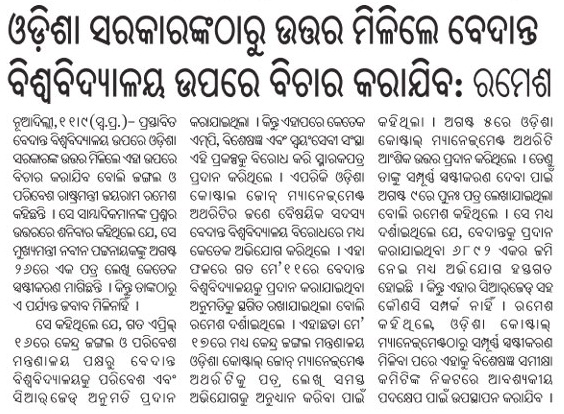
September 12th, 2010
Update: IIT Kharagpur and IIT Hyderabad are keen on having medical schools.
Following is an excerpt from a report in Times of India.
The prestigious Indian Institutes of Technology would now offer courses in medicine with foreign nationals on permanent faculty positions and students from abroad at the post graduate level.
A decision to this effect was taken at a meeting of IIT council presided by HRD Minister Kapil Sibal on Friday.
The government decided to seek the approval of the Medical Council of India for the course, Sibal told reporters.
The IIT council meeting decided to carry out appropriate amendment in the Institute of Technologies Act to enable the IITs to offer the medicine programme, he added.
"We are making sure that wherever the instruction leads to a degree relating to any branch of medicine, then of course clearances from MCI under the Act will have to be taken," Sibal said.
He, however, said no MCI approval would be required where IITs engage with inter-disciplinary research for the advancement of learning and dissemination of knowledge not leading to a degree or qualification for the practice of medicine.
… The council also decided to enable IITs to recruit foreign faculties which should not be more than 10 per cent of the total faculty strength.
"In principle, we agreed that IITs are entitled to recruiting foreign faculties", Sibal said adding they will set up a mechanism with the Home Ministry to ensure there is no "hiccup in the process and there is easy exit and entry of people" as faculties.
Some other issues like bringing amendments to the Indian Citizenship Act will also have to be looked into, he said.
… Sibal said the meeting also agreed in principle to admit up to 25 per cent foreign students at the post graduate level on a "supernumerary basis without affecting the present admission norms for Indian students".
On medical schools at IIT, the main bone of contention was that IITs would have preferred that the medical schools in IITs do not have to get approval from the Medical Council of India. This would have been similar to them not needing approval from AICTE for their engineering programs. But the health ministry would not agree to that. So now the IITs are ready to accept MCI authority over their medical schools. This solves the problem.
September 10th, 2010
Following is an excerpt from a report in Times of India.
Facing a massive shortage of well-qualified teachers, the prestigious Indian Institutes of Technology (IIT) have mooted a proposal for hiring foreign nationals as permanent faculty members.
With one-third teaching positions lying vacant, the proposal as a solution to meet the unprecedented staff crunch is expected to be deliberated at the next IIT council meeting on Friday, IIT officials said.
The move, if accepted, would enable the premier engineering and technology institutes to appoint foreign teachers on permanent positions, up to 10 per cent of the faculty strength.
I hope this proposal by the IITs is approved and the limit is increased from the proposed 10%.
Most universities in US, Europe, Australia, Hong Kong, Singapore etc. are able to hire foreign faculty in permanent positions. The inability of IITs and other Indian institutions to do that hurts them. This will also serve as an experiment to see how attractive the salary offered by the IITs is to foreign faculty that are not of Indian origin. The data and experience gathered from this experiment will be useful for the universities of innovation which are supposed to be unconstrained by the government in terms of salary offered to its faculty. The concept note of these universities already talked about allowing hiring of foreign faculty.
September 9th, 2010
Following is from a report in Indian Express.
The proposal to set up new specialized Navodaya Vidyalayas to be termed as ‘Science Magnet’ schools, in collaboration with top R&D institutes, got the go-ahead from the Indian Institutes of Science Education & research (IISER) on Tuesday.
At a meeting with the Human Resource Development (HRD) minister Kapil Sibal, IISER directors said that such schools would allow an integrated approach to science education from school to university level. IISER Thiruvananthapuram director has also committed to helping to provide an enabling environment to students enrolled in these Science Magnet schools. The Planning Commission is also learnt to have accorded, in principal, approval for the proposal.
These specialized Navodaya schools will only cater to students from classes IX to XII and will be set up over the next three years. The idea came up in light of the huge shortage of science graduates and post-graduates in the country and the diminishing interest in core science subjects.
Institutes like IISERs, Indian Institute of Science, National Physical Laboratory, Bhaba Atomic Research Centre, Council for Science & Industrial Research (CSIR) will be approached to help these schools which will be located in close proximity to these R&D institutes.
Initially I misread and thought that the IISERs agreed to have science magnet schools in their campus. The above report just says that they agree to the concept. Related reports say that they agree to accept students with IB (International Baccalaureate) degrees. That is important because the science magnet schools may need to get away from CBSE/ICSE/state-board and have IB so as to have a flexible curriculum that allows more courses in science and mathematics. The standard CBSE/ICSE/state-board does not have that flexibility.
I guess the reason an ok from the IISERs is important is because these schools are targeted to be feeder schools to IISERs.
September 8th, 2010
Following is from a report in Indian Express.
As Anil Agarwal-owned Vedanta Resources battles to save its 1 MTPA alumina refinery project at Lanjigarh in Kalahandi district from the axe of Ministry of Environment and Forests, the much-vaunted Vedanta University project in Puri is for all practical purposes a closed chapter.
The proposed Rs 150 billion university seemed futuristic and sounded too-good-to-be-true when Agarwal signed the MoU in 2006 with the Orissa government. It was claimed that when completed the world-class multi-disciplinary university over an area of 6,800 acres on Puri-Konark marine drive would be at par with Harvard and Oxford universities. The university, when fully operational, was to have an intake of 100,000 students with cutting-edge research facility in 95 academic disciplines. But local opposition, problems over land acquisition and the MoEF’s spanners seem to have taken the wind out of its sail.
“The project is as good as over,” said a Vedanta official. The company’s officials confirmed that Vedanta has shifted 26 of its 30 staff at the site to other locations and all work has been put on halt.
Though the Anil Agarwal Foundation (a registered not-for-profit entity controlled by members of the Agarwal family) had acquired 4,500 acres of the 6,892 acres allotted to it on paper, it was unable to take physical possession of the land due to local opposition. Even the initial plan to build a 500-bed super-speciality hospital at the site met with hostility, the official added.
The first bottleneck for the project came in March this year when Orissa Lok Pal Justice P K Patra recommended a moratorium on the project till the Foundation complied with legal provisions pointed out by the Ministry of Company Affairs for conversion of its status from private to public company. The Lok Pal said the Foundation was a private company and thus the state government can’t acquire any land for it.
Acting on a petition of trade union leader Dwarika Mohan Mishra, the Lok Pal held that Land Acquisition Act and Section 16 of Shri Jagannath Temple Act, 1954 have been violated by the government. The Lok Pal asked the Chief Minister to appoint a competent authority to investigate and inquire into the land deal and take appropriate action against the erring persons.
The university project faced another big hurdle when the MoEF on May 11 kept the conditional environmental and Coastal Regulatory Zone clearance in abeyance over allegations of irregularities, illegal and unlawful deeds by the Foundation.
With the project facing so many bottlenecks, Vedanta officials said the project may go to Andhra Pradesh or Karnataka. Both Karnataka and Andhra Pradesh have sent feelers to Agarwal assuring him all support.
September 8th, 2010
Following is from Samaja. Everyone is entitled to their opinion but at least they should check facts.
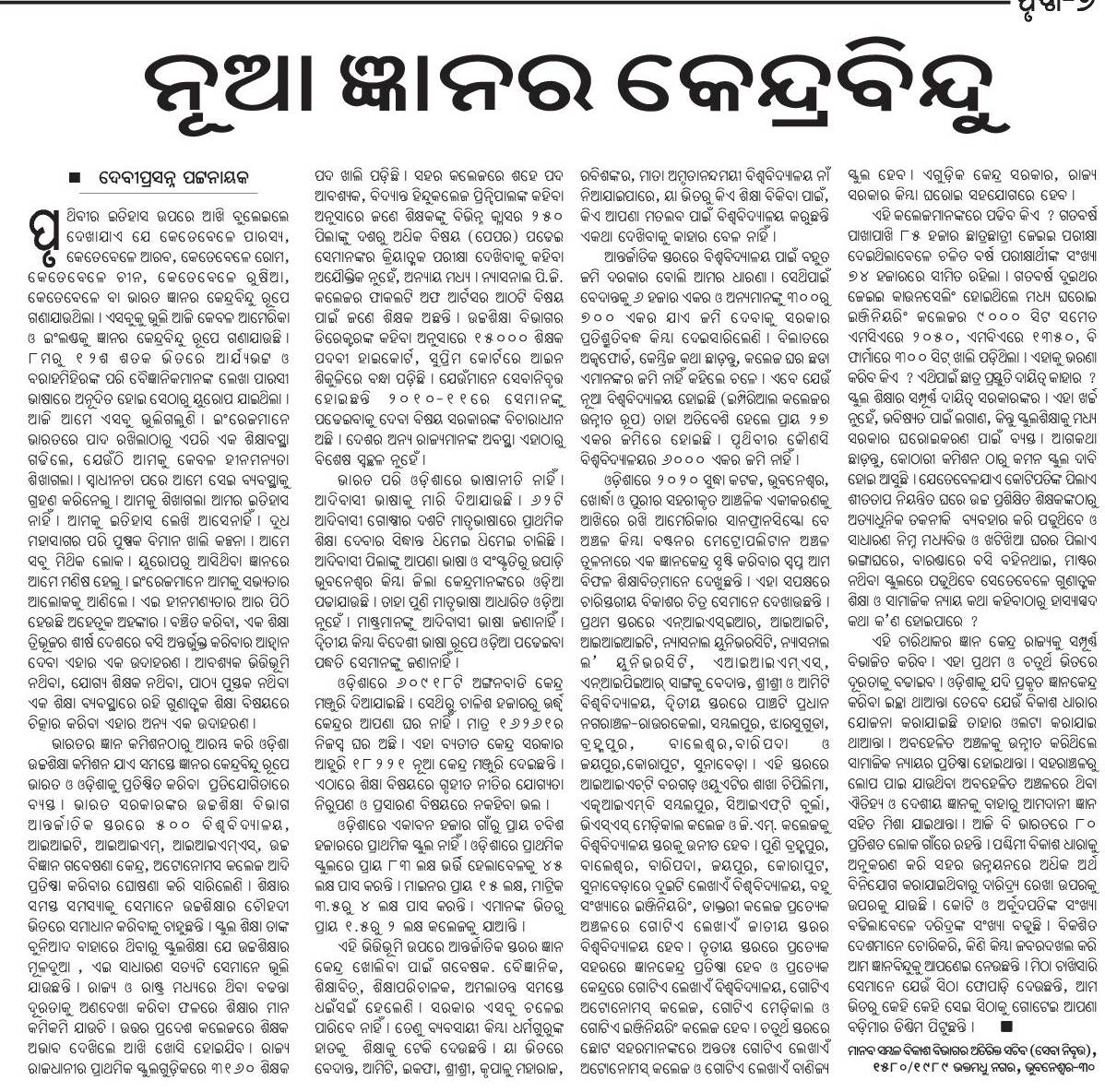
September 7th, 2010
Following is from a report from Business Standard (via sify.com).
… After rejection of the Stage-II forest clearance for proposed bauxite mining by Vedanta Aluminium Limited (VAL), the Union Ministry of Environment and Forest (MoEF) appears to have trained its guns on the proposed Vedanta University Project (VUP) in the state.
The MoEF, which had suspended the environmental clearance for the university project in May this year over the issues pertaining to the alleged violations of Coastal Regulatory Zone (CRZ) norms, has sought additional information and clarification from the state government.
In a letter to the state Chief Minister Naveen Patnaik datd August 26, the Union minister for environment and forest Jairam Ramesh has stated that the information furnished by the Orissa Coastal Zone Management Authority (OCZMA) is not adequate and more information needs to be submitted.
Ramesh has stated in the letter that OCZMA has not furnished the requisite information despite the reminder of the ministry last month.
The MoEF can place the VUP project before the Expert Appraisal Committee only after the receipt of the said information.
Ramesh has also stated that he has received allegations of violations of CRZ norms at the VUP site from MPs, MLAs and even a member of the technical committee of the OCZMA.
It may be noted that the MoEF had granted the environmental nod as well as CRZ clearance for the VUP in April this year.
The VUP to be developed by the Anil Agarwal Foundation has been envisioned to be a multi-disciplinary university of international standards on the Puri-Konark marine drive at an investment of Rs 5000 crore.
The university which will have an intake of 100,000 students will be spread over 6892 acres with a total construction area of 273.68 lakh sq metres.
The university will have provision for quality higher education and cutting-edge research facility in 95 academic disciplines.
Within the planned construction area of the university project, 1500 acres will be devoted to academic block, 1200 acres will be set aside for R&D centre and research work while 1092 acres will be earmarked for green belt and open spaces.
Besides, a township will be built over 2100 acres for the faculty and other staff of the university.
A sports complex spread over 100 acres and an exhibition centre on 100 acres of land are also set to come up as a part of the project.
September 7th, 2010
Next Posts
Previous Posts

